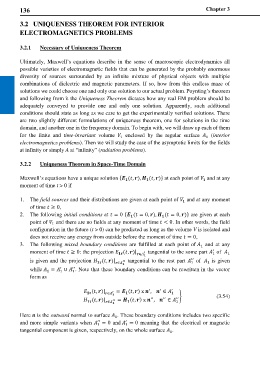Page 156 - Maxwell House
P. 156
136 Chapter 3
3.2 UNIQUENESS THEOREM FOR INTERIOR
ELECTROMAGNETICS PROBLEMS
3.2.1 Necessary of Uniqueness Theorem
Ultimately, Maxwell’s equations describe in the sense of macroscopic electrodynamics all
possible varieties of electromagnetic fields that can be generated by the probably enormous
diversity of sources surrounded by an infinite mixture of physical objects with multiple
combinations of dielectric and magnetic parameters. If so, how from this endless maze of
solutions we could choose one and only one solution to our actual problem. Poynting’s theorem
and following from it the Uniqueness Theorem dictates how any real EM problem should be
adequately conveyed to provide one and only one solution. Apparently, such additional
conditions should state as long as we care to get the experimentally verified solutions. There
are two slightly different formulations of uniqueness theorem, one for solutions in the time
domain, and another one in the frequency domain. To begin with, we will draw up each of them
for the finite and time-invariant volume enclosed by the regular surface (interior
1
1
electromagnetics problems). Then we will study the case of the asymptotic limits for the fields
at infinity or simply A at “infinity” (radiation problems).
3.2.2 Uniqueness Theorem in Space-Time Domain
Maxwell’s equations have a unique solution { (, ), (, )} at each point of and at any
1
moment of time t > 0 if
1. The field sources and their distributions are given at each point of and at any moment
1
of time ≥ 0,
2. The following initial conditions at = 0 { ( = 0, ), ( = 0, )} are given at each
point of and there are no fields at any moment of time < 0. In other words, the field
1
configuration in the future (t > 0) can be predicted as long as the volume V is isolated and
does not receive any energy from outside before the moment of time = 0,
3. The following mixed boundary conditions are fulfilled at each point of and at any
1
′
moment of time ≥ 0: the projection (, )| ′ tangential to the some part of
∈ 1 1 1
′′
is given and the projection (, )| ′′ tangential to the rest part of is given
∈ 1 1 1
while = ∪ . Note that these boundary conditions can be rewritten in the vector
′
′′
1
1
1
form as
′
′
′
(, )| ′ = (, ) x , ∈
∈ 1 1 � (3.54)
′′
′′
(, )| ∈ 1 ′′ = (, ) x , ∈ ′′
1
Here n is the outward normal to surface . These boundary conditions includes two specific
1
and more simple variants when = 0 and = 0 meaning that the electrical or magnetic
′′
′
1
1
tangential component is given, respectively, on the whole surface .
1

